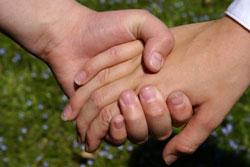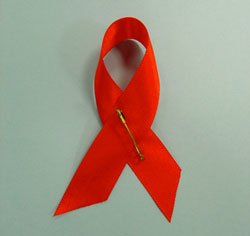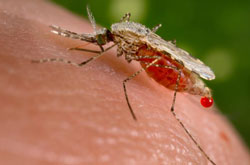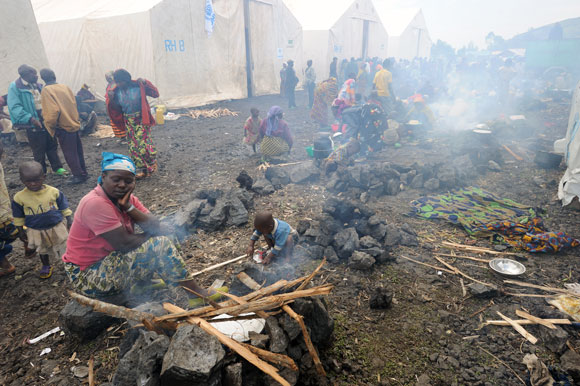Pathogens cause disease
Pathogens are all around us in the environment every day. Soil contains millions of bacteria per cubic centimetre, fungal spores are in the air that we breathe and microorganism are deposited when pets or people touch surfaces like tables or kitchen work-tops.
How pathogens are spread
There are lots of different ways in which pathogens can be spread to cause disease.
|
Droplet infection (though the nose) |
When you cough, sneeze or talk tiny droplets fly out of your mouth and nose. If you have an infection, those droplets will contain microorganisms. Other people breathe in the droplets, along with the viruses or bacteria they contain. Diseases such as tuberculosis and the common cold are spread in this way |
 Photo courtesy of CDC
Photo courtesy of CDC
|
|
Direct contact (eg reproductive organs) |
Some diseases are spread by direct contact of the skin and some sexually transmitted diseases like genital herpes |

|
|
Contaminated food (through the mouth) |

|
|
|
Contaminated water (through the mouth) |
Drinking water contaminated by sewage means you take large numbers of microorganisms straight into your gut eg cholera and amoebic dysentery. Anywhere without proper sewage treatment and disposal is at risk of these diseases. |

|
|
By body fluids (through breaks in the skin) |
 Photo courtesy of AVERT
Photo courtesy of AVERT
|
|
|
Vectors (usually through the skin or through the mouth) |
 Photo courtesy of CDC/Dr William Collins
Photo courtesy of CDC/Dr William Collins
|
In shanty towns and slums around the world, and wherever there is a natural disaster, you find many of the conditions which lead to the easy spread of disease.
- People are displaced from their homes and are crowded together so droplet infection happens easily.
- Damaged sewage systems and water supplies mean the water is often contaminated with sewage.
- Damaged electrical supplies mean fridges don't work, so food goes off quickly and flies and other insects often contaminate the food.
- Malaria mosquitoes may breed in standing water.
- Health services are disrupted so diseases cannot be treated quickly so they spread fast.

Natural disasters mean many different ways of spreading pathogens all come together to cause a major health risk.
This may cause more deaths than the original disaster
Courtesy of Julien Harneis
Antibiotic
Medicine that acts against
bacterial infections. Penicillin is an example of an
antibiotic.
Antibody
Protein that is produced by
lymphocytes (white blood cells) and that attaches to a
specific antigen.
Antigen
Molecule on the surface of a
pathogen that identifies it as a foreign invader to the
immune system.
Bacteria
Single-celled organism. Has a cell
wall, cell membrane, cytoplasm. Its DNA is loosely-coiled in
the cytoplasm and there is no distinct nucleus.
Biotechnology
The use of biological organisms or
enzymes to create, break down or transform a material
Dissect
To cut apart, or separate, tissue
especially for anatomical study.
Exponential growth
If something is growing
exponentially the larger the quantity gets, the faster it
grows
Fungus
Micro-organism that can grow in
long tubes called hyphae or as single cells. Fungi have a
nucleus, cytoplasm and a cell wall.
Herd immunity
If a high percentage of a
population is immune to a disease the disease cannot be
passed on because it cannot find new hosts.
HIV/AIDS
Infection caused by the human
immunodeficiency virus (HIV). It attacks and destroys the
immune system.
Hybridoma
Hybridoma cells are formed by
fusing a specific antibody-producing cell with a type of
cancer cell that grows well in tissue culture
Immune system
The body's natural defence
mechanism against infectious diseases.
Immunisation
A process which gives immune
resistance to a particular disease. The human or animal is
exposed to a harmless antigen in order to raise antibodies
and provide an immune memory.
Lymphocyte
A type of white blood cell that
make antibodies to fight off infections.
Macrophage
A type of white blood cell that
consumes dead pathogens that have been killed by
antibodies.
Parasite
Organism that feeds off another
living host and causes it some damage. An example of a
parasite is a tapeworm that lives in the digestive system of
a host organism.
Pathogen
A micro-organism that causes
disease.
Phagocyte
Phagocytes are the white blood
cells that protect the body by ingesting harmful foreign
particles, bacteria, and dead or dying cells.
Protein
A polymer made up of amino acids
joined by peptide bonds. The amino acids present and the
order in which they occur vary from one protein to
another.
Protozoa
Protozoa are one-celled
animals
Spore
A spore is a reproductive
structure that is adapted for dispersal and surviving for
extended periods of time in unfavourable conditions.
Toxin
A poisonous or toxic substance -
produced by pathogens.
Vaccination
A small amount of dead or weakened
pathogen is introduced into the body. It prepares the immune
system to prevent future infections with the live
pathogen.
Vaccine
Medicine that contains a dead or
weakened pathogen. It stimulates the immune system so that
the vaccinated person has an immunity against that particular
disease.
Virus
The smallest of living organisms.
Viruses are made up of a ball of protein that contains a
small amount of the virus DNA. They can only reproduce after
they have infected a host cell.
Opportunistic Infections
An infection that would not normally cause disease in a healthy person but which can take hold when a person's normal immune defences are reduced.















